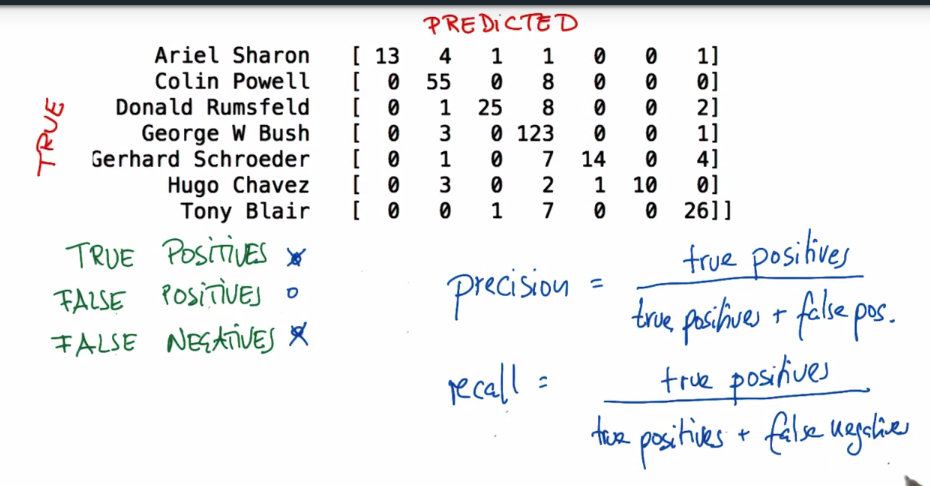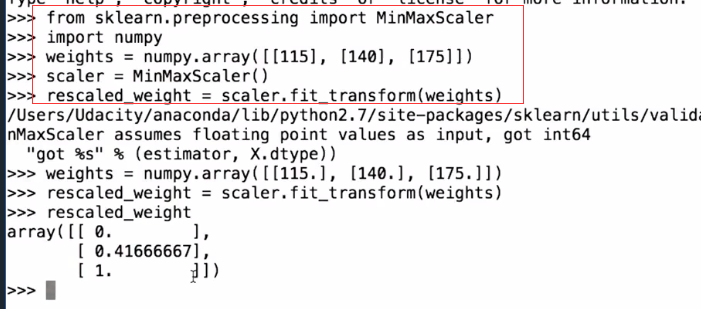sklearn API:http://scikit-learn.org/stable/modules/classes.html#module-sklearn.model_selection
GaussianNB
有关地形数据的GaussianNB 部署:

#!/usr/bin/python """ Complete the code in ClassifyNB.py with the sklearn Naive Bayes classifier to classify the terrain data. The objective of this exercise is to recreate the decision boundary found in the lesson video, and make a plot that visually shows the decision boundary """ from prep_terrain_data import makeTerrainData from class_vis import prettyPicture, output_image from ClassifyNB import classify from sklearn.naive_bayes import GaussianNB import numpy as np import pylab as pl features_train, labels_train, features_test, labels_test = makeTerrainData() ### the training data (features_train, labels_train) have both "fast" and "slow" points mixed ### in together--separate them so we can give them different colors in the scatterplot, ### and visually identify them grade_fast = [features_train[ii][0] for ii in range(0, len(features_train)) if labels_train[ii]==0] bumpy_fast = [features_train[ii][1] for ii in range(0, len(features_train)) if labels_train[ii]==0] grade_slow = [features_train[ii][0] for ii in range(0, len(features_train)) if labels_train[ii]==1] bumpy_slow = [features_train[ii][1] for ii in range(0, len(features_train)) if labels_train[ii]==1] # You will need to complete this function imported from the ClassifyNB script. # Be sure to change to that code tab to complete this quiz. clf = classify(features_train, labels_train) ### draw the decision boundary with the text points overlaid prettyPicture(clf, features_test, labels_test) output_image("test.png", "png", open("test.png", "rb").read())

#!/usr/bin/python #from udacityplots import * import warnings warnings.filterwarnings("ignore") import matplotlib matplotlib.use('agg') import matplotlib.pyplot as plt import pylab as pl import numpy as np #import numpy as np #import matplotlib.pyplot as plt #plt.ioff() def prettyPicture(clf, X_test, y_test): x_min = 0.0; x_max = 1.0 y_min = 0.0; y_max = 1.0 # Plot the decision boundary. For that, we will assign a color to each # point in the mesh [x_min, m_max]x[y_min, y_max]. h = .01 # step size in the mesh xx, yy = np.meshgrid(np.arange(x_min, x_max, h), np.arange(y_min, y_max, h)) Z = clf.predict(np.c_[xx.ravel(), yy.ravel()]) # Put the result into a color plot Z = Z.reshape(xx.shape) plt.xlim(xx.min(), xx.max()) plt.ylim(yy.min(), yy.max()) plt.pcolormesh(xx, yy, Z, cmap=pl.cm.seismic) # Plot also the test points grade_sig = [X_test[ii][0] for ii in range(0, len(X_test)) if y_test[ii]==0] bumpy_sig = [X_test[ii][1] for ii in range(0, len(X_test)) if y_test[ii]==0] grade_bkg = [X_test[ii][0] for ii in range(0, len(X_test)) if y_test[ii]==1] bumpy_bkg = [X_test[ii][1] for ii in range(0, len(X_test)) if y_test[ii]==1] plt.scatter(grade_sig, bumpy_sig, color = "b", label="fast") plt.scatter(grade_bkg, bumpy_bkg, color = "r", label="slow") plt.legend() plt.xlabel("bumpiness") plt.ylabel("grade") plt.savefig("test.png") import base64 import json import subprocess def output_image(name, format, bytes): image_start = "BEGIN_IMAGE_f9825uweof8jw9fj4r8" image_end = "END_IMAGE_0238jfw08fjsiufhw8frs" data = {} data['name'] = name data['format'] = format data['bytes'] = base64.encodestring(bytes) print image_start+json.dumps(data)+image_end

#!/usr/bin/python import random def makeTerrainData(n_points=1000): ############################################################################### ### make the toy dataset random.seed(42) grade = [random.random() for ii in range(0,n_points)] bumpy = [random.random() for ii in range(0,n_points)] error = [random.random() for ii in range(0,n_points)] y = [round(grade[ii]*bumpy[ii]+0.3+0.1*error[ii]) for ii in range(0,n_points)] for ii in range(0, len(y)): if grade[ii]>0.8 or bumpy[ii]>0.8: y[ii] = 1.0 ### split into train/test sets X = [[gg, ss] for gg, ss in zip(grade, bumpy)] split = int(0.75*n_points) X_train = X[0:split] X_test = X[split:] y_train = y[0:split] y_test = y[split:] grade_sig = [X_train[ii][0] for ii in range(0, len(X_train)) if y_train[ii]==0] bumpy_sig = [X_train[ii][1] for ii in range(0, len(X_train)) if y_train[ii]==0] grade_bkg = [X_train[ii][0] for ii in range(0, len(X_train)) if y_train[ii]==1] bumpy_bkg = [X_train[ii][1] for ii in range(0, len(X_train)) if y_train[ii]==1] # training_data = {"fast":{"grade":grade_sig, "bumpiness":bumpy_sig} # , "slow":{"grade":grade_bkg, "bumpiness":bumpy_bkg}} grade_sig = [X_test[ii][0] for ii in range(0, len(X_test)) if y_test[ii]==0] bumpy_sig = [X_test[ii][1] for ii in range(0, len(X_test)) if y_test[ii]==0] grade_bkg = [X_test[ii][0] for ii in range(0, len(X_test)) if y_test[ii]==1] bumpy_bkg = [X_test[ii][1] for ii in range(0, len(X_test)) if y_test[ii]==1] test_data = {"fast":{"grade":grade_sig, "bumpiness":bumpy_sig} , "slow":{"grade":grade_bkg, "bumpiness":bumpy_bkg}} return X_train, y_train, X_test, y_test # return training_data, test_data

from sklearn.naive_bayes import GaussianNB def classify(features_train, labels_train): ### import the sklearn module for GaussianNB ### create classifier ### fit the classifier on the training features and labels ### return the fit classifier ### your code goes here! clf=GaussianNB() clf.fit(features_train,labels_train) return clf.fit(features_train,labels_train)
计算 GaussianNB 准确性:

def NBAccuracy(features_train, labels_train, features_test, labels_test): """ compute the accuracy of your Naive Bayes classifier """ ### import the sklearn module for GaussianNB from sklearn.naive_bayes import GaussianNB ### create classifier clf = GaussianNB() ### fit the classifier on the training features and labels #TODO clf.fit(features_train,labels_train) ### use the trained classifier to predict labels for the test features pred = clf.predict(features_test) ### calculate and return the accuracy on the test data ### this is slightly different than the example, ### where we just print the accuracy ### you might need to import an sklearn module from sklearn.metrics import accuracy_score # print accuracy_score(pred,labels_test) accuracy =accuracy_score(pred,labels_test) return accuracy

from class_vis import prettyPicture from prep_terrain_data import makeTerrainData from classify import NBAccuracy import matplotlib.pyplot as plt import numpy as np import pylab as pl features_train, labels_train, features_test, labels_test = makeTerrainData() def submitAccuracy(): accuracy = NBAccuracy(features_train, labels_train, features_test, labels_test) return accuracy
支持向量机(sport vertor)
1、使用参考资料:http://scikit-learn.org/stable/modules/svm.html
2、支持向量机相关代码:

import sys from class_vis import prettyPicture from prep_terrain_data import makeTerrainData import matplotlib.pyplot as plt import copy import numpy as np import pylab as pl features_train, labels_train, features_test, labels_test = makeTerrainData() ########################## SVM ################################# ### we handle the import statement and SVC creation for you here from sklearn.svm import SVC clf = SVC(kernel="linear") #### now your job is to fit the classifier #### using the training features/labels, and to #### make a set of predictions on the test data clf.fit(features_train,labels_train) #### store your predictions in a list named pred pred=clf.predict(features_test) from sklearn.metrics import accuracy_score acc = accuracy_score(pred, labels_test) def submitAccuracy(): return acc
决策树(decision tree)
1、参考资料:http://scikit-learn.org/stable/modules/tree.html
http://www.jianshu.com/p/c2916d616acc
2、相关代码:

#!/usr/bin/python """ lecture and example code for decision tree unit """ import sys from class_vis import prettyPicture, output_image from prep_terrain_data import makeTerrainData import matplotlib.pyplot as plt import numpy as np import pylab as pl from classifyDT import classify features_train, labels_train, features_test, labels_test = makeTerrainData() ### the classify() function in classifyDT is where the magic ### happens--fill in this function in the file 'classifyDT.py'! clf = classify(features_train, labels_train) #### grader code, do not modify below this line prettyPicture(clf, features_test, labels_test) output_image("test.png", "png", open("test.png", "rb").read()) 复制代码

def classify(features_train, labels_train): ### your code goes here--should return a trained decision tree classifer from sklearn import tree clf=tree.DecisionTreeRegressor() pred=clf.fit(features_train,labels_train) return pred
决策树的准确性:

import sys from class_vis import prettyPicture from prep_terrain_data import makeTerrainData import numpy as np import pylab as pl features_train, labels_train, features_test, labels_test = makeTerrainData() ################################################################################# ########################## DECISION TREE ################################# #### your code goes here from sklearn import tree clf=tree.DecisionTreeRegressor() clf.fit(features_train,labels_train) pred=clf.predict(features_test) from sklearn.metrics import accuracy_score acc = accuracy_score(pred, labels_test) #acc = ### you fill this in! ### be sure to compute the accuracy on the test set def submitAccuracies(): return {"acc":round(acc,3)}
决策树参数:

通过使用决策树参数min_samples_split=2,min_samples_split=50比较决策树的准确性

import sys from class_vis import prettyPicture from prep_terrain_data import makeTerrainData import matplotlib.pyplot as plt import numpy as np import pylab as pl features_train, labels_train, features_test, labels_test = makeTerrainData() ########################## DECISION TREE ################################# ### your code goes here--now create 2 decision tree classifiers, ### one with min_samples_split=2 and one with min_samples_split=50 ### compute the accuracies on the testing data and store ### the accuracy numbers to acc_min_samples_split_2 and ### acc_min_samples_split_50, respectively from sklearn import tree clf_2=tree.DecisionTreeClassifier(min_samples_split=2) clf_2.fit(features_train,labels_train) pred_2=clf_2.predict(features_test) clf_50=tree.DecisionTreeClassifier(min_samples_split=50) clf_50.fit(features_train,labels_train) pred_50=clf_50.predict(features_test) from sklearn.metrics import accuracy_score acc_min_samples_split_2=accuracy_score(pred_2,labels_test) acc_min_samples_split_50=accuracy_score(pred_50,labels_test) from sklearn.tree import DecisionTreeClassifier def submitAccuracies(): return {"acc_min_samples_split_2":round(acc_min_samples_split_2,3), "acc_min_samples_split_50":round(acc_min_samples_split_50,3)}
运行结果:
{"message": "{'acc_min_samples_split_50': 0.912, 'acc_min_samples_split_2': 0.908}"}
熵、条件熵、信息增益:
参考:https://www.zhihu.com/question/22104055
熵:表示随机变量的不确定性。
条件熵:在一个条件下,随机变量的不确定性。
信息增益:熵 - 条件熵
线性回归(linearRegression)
1、搜索sklearn regression 可找到相关资料
2、参考资料:http://scikit-learn.org/stable/modules/generated/sklearn.linear_model.LinearRegression.html
3、相关代码:
年龄/净值回归代码

#!/usr/bin/python import numpy import matplotlib matplotlib.use('agg') import matplotlib.pyplot as plt from studentRegression import studentReg from class_vis import prettyPicture, output_image from ages_net_worths import ageNetWorthData ages_train, ages_test, net_worths_train, net_worths_test = ageNetWorthData() reg = studentReg(ages_train, net_worths_train) plt.clf() plt.scatter(ages_train, net_worths_train, color="b", label="train data") plt.scatter(ages_test, net_worths_test, color="r", label="test data") plt.plot(ages_test, reg.predict(ages_test), color="black") plt.legend(loc=2) plt.xlabel("ages") plt.ylabel("net worths") plt.savefig("test.png") output_image("test.png", "png", open("test.png", "rb").read())

def studentReg(ages_train, net_worths_train): ### import the sklearn regression module, create, and train your regression ### name your regression reg ### your code goes here! from sklearn.linear_model import LinearRegression clf=LinearRegression() reg=clf.fit(ages_train,net_worths_train) return reg
reg.coef_ :斜率
reg.intercept:截距
reg.score:

在sklearn 中训练/测试分离
参考:http://scikit-learn.org/stable/modules/cross_validation.html
X_train, X_test, y_train, y_test = train_test_split(
... iris.data, iris.target, test_size=0.4, random_state=0)
相关代码:

#!/usr/bin/python """ PLEASE NOTE: The api of train_test_split changed and moved from sklearn.cross_validation to sklearn.model_selection(version update from 0.17 to 0.18) The correct documentation for this quiz is here: http://scikit-learn.org/0.17/modules/cross_validation.html """ from sklearn import datasets from sklearn.svm import SVC iris = datasets.load_iris() features = iris.data labels = iris.target ############################################################### ### YOUR CODE HERE ############################################################### ### import the relevant code and make your train/test split ### name the output datasets features_train, features_test, ### labels_train, and labels_test # PLEASE NOTE: The import here changes depending on your version of sklearn from sklearn import cross_validation # for version 0.17 # For version 0.18 # from sklearn.model_selection import train_test_split ### set the random_state to 0 and the test_size to 0.4 so ### we can exactly check your result features_train, features_test, labels_train, labels_test = cross_validation.train_test_split(iris.data, iris.target, test_size=0.4, random_state=0) ############################################################### # DONT CHANGE ANYTHING HERE clf = SVC(kernel="linear", C=1.) clf.fit(features_train, labels_train) print clf.score(features_test, labels_test) ############################################################## def submitAcc(): return clf.score(features_test, labels_test)

def submitAcc(): return clf.score(features_test, labels_test)
结果:0.966666666667
k折交叉验证(k-fold cross validation)
sklearn中的 GridSearchCV
GridSearchCV 用于系统地遍历多种参数组合,通过交叉验证确定最佳效果参数。它的好处是,只需增加几行代码,就能遍历多种组合。
下面是来自 sklearn 文档 的一个示例:
parameters = {'kernel':('linear', 'rbf'), 'C':[1, 10]}
svr = svm.SVC()
clf = grid_search.GridSearchCV(svr, parameters)
clf.fit(iris.data, iris.target)
让我们逐行进行说明。
parameters = {'kernel':('linear', 'rbf'), 'C':[1, 10]}
参数字典以及他们可取的值。在这种情况下,他们在尝试找到 kernel(可能的选择为 'linear' 和 'rbf' )和 C(可能的选择为1和10)的最佳组合。
这时,会自动生成一个不同(kernel、C)参数值组成的“网格”:
| ('rbf', 1) | ('rbf', 10) |
|---|---|
| ('linear', 1) | ('linear', 10) |
各组合均用于训练 SVM,并使用交叉验证对表现进行评估。
svr = svm.SVC()
这与创建分类器有点类似,就如我们从第一节课一直在做的一样。但是请注意,“clf” 到下一行才会生成—这儿仅仅是在说采用哪种算法。另一种思考方法是,“分类器”在这种情况下不仅仅是一个算法,而是算法加参数值。请注意,这里不需对 kernel 或 C 做各种尝试;下一行才处理这个问题。
clf = grid_search.GridSearchCV(svr, parameters)
这是第一个不可思议之处,分类器创建好了。 我们传达算法 (svr) 和参数 (parameters) 字典来尝试,它生成一个网格的参数组合进行尝试。
clf.fit(iris.data, iris.target)
第二个不可思议之处。 拟合函数现在尝试了所有的参数组合,并返回一个合适的分类器,自动调整至最佳参数组合。现在您便可通过 clf.best_params_ 来获得参数值。
精确率(prcision)与召回率(recall)
以Colin Powell为例子
true positive (真正例):把Colin Powell预测成Colin Powell(55)
false positive(假正例):把其他人预测成Colin Powell(4+1+3+1+3)
false negative(假负例):把Colin Powell预测成其他人(8)

F1 分数
既然我们已讨论了精确率和召回率,接下来可能要考虑的另一个指标是 F1 分数。F1 分数会同时考虑精确率和召回率,以便计算新的分数。
可将 F1 分数理解为精确率和召回率的加权平均值,其中 F1 分数的最佳值为 1、最差值为 0:
F1 = 2 * (精确率 * 召回率) / (精确率 + 召回率)
有关 F1 分数和如何在 sklearn 中使用它的更多信息,请查看此链接此处。
特征缩放
http://scikit-learn.org/stable/modules/preprocessing.html

